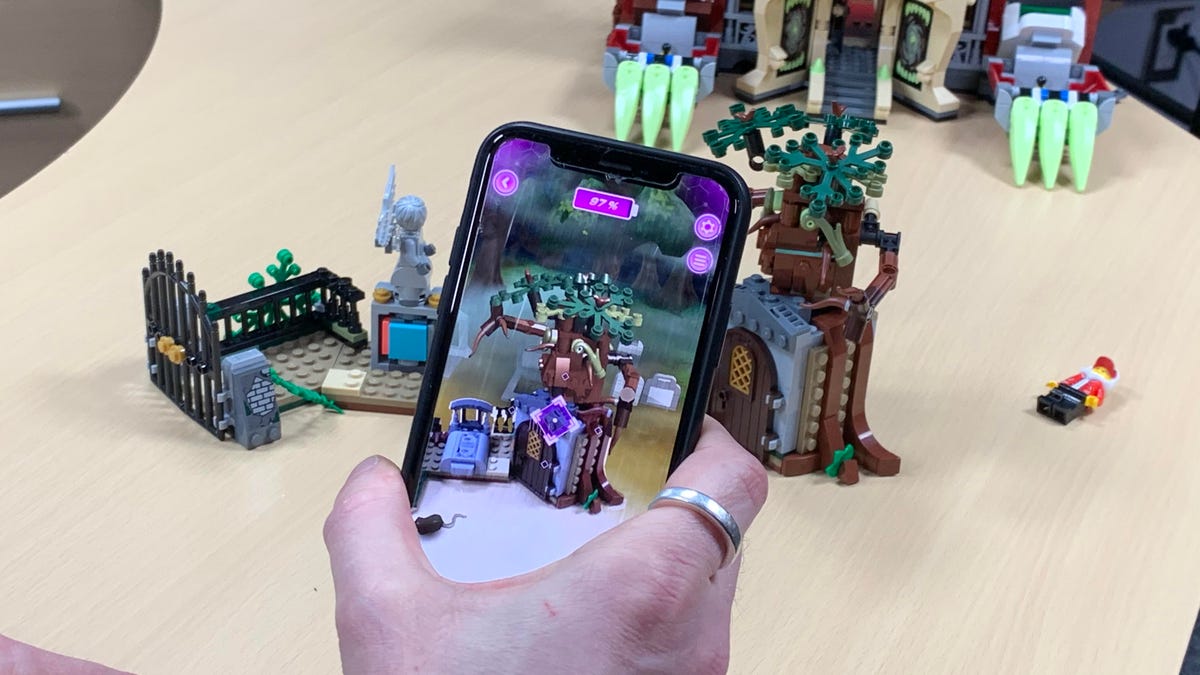Toy Fair 2019: Lego Hidden Side is like a tiny AR Ghostbusters escape room
Ghost-hunting through a phone in AR, in tiny brick kits.

AR ghosts! (Lego-style.)
I'm looking at a Lego brick construction sitting on our office table and I don't know what to make of it. It's an old mansionlike building that feels Harry Potter-esque. The building's sides bend down, windows flip open and now it's a snarling beast. I'm handed a phone, and I aim an app at the bricks. I see virtual ghosts start to appear, blending with the physical bricks. This now fits the synopsis Lego handed me:
"Jack and Parker are teenage bloggers who attend Newbury High School. Through an app on their mobile phones , they can see the unseen -- and in this case, Newbury is overrun with ghosts!"
Spooky school.
Lego: Hidden Side isn't the first augmented-reality-enabled construction set Lego's made, but it's the first line designed to work with AR from the ground up. The sets tell a tale about a haunted world where ghosts lurk, and it's a self-contained story world such as Ninjago or Nexo Knights. The sets will cost between $20 and $130 when they arrive later this summer (Roughly £15-£100 or AU$30-AU$180 converted.)
An AR-equipped phone app finds the ghosts in the set and sucks them up, collecting them like Pokemon. The kits feel like little movie sets, where the game plays out via augmented-reality characters that appear on the tiny stages. You don't technically need to use the phone app to put Hidden Side sets together, but the extra gameplay and missions are a big part of the package. Lego promises a number of unfolding puzzle challenges in each set, and a possibility of new events that unfold over time.
I was immediately reminded of Nintendo 's ghost-hunting Luigi's Mansion game, but in this case there are actual physical Lego bricks. That, and of course, Ghostbusters, plus a bit of Pokemon Go. Lego's previous AR apps for specific Lego kits were built off Apple 's ARKit. Lego: Hidden Side's inspiration started further back, with the success of app-enabled kits like Lego Nexo Knights. Lego's AR app for Hidden Side was custom-built to work with both iPhones and AR-ready Android phones, but that also means no multiplayer (a feature that's possible in Lego Playgrounds, which allows more than one person to see the blend of Lego bricks and virtual AR objects with multiple phones/tablets).
Once the different sets are assembled, little hidden puzzles lurk inside that trigger events. Maybe a moving panel, or a treasure chest where a ghost is hidden. Color-changing panels also sync up with different "ghost lens" spectrums in the phone game: Red, blue and yellow lenses shift worlds and help find more spirits.
Collecting some basic ghosts.
The overlap of real pieces and virtual effects and AR objects seen in-phone looked pretty good, maybe even a step up from the Playgrounds app. A Lego tree suddenly turned into a haunted, animated object, and other parts of the set seemed to come alive. But, yeah, you have to hold a phone in your hand.
The Lego: Hidden Side sets are meant to stay constructed so you can play the game, so if your kids are like mine and start mashing up sets and breaking down stuff as soon as they've made it, this probably isn't for you. Also, the whole experience is designed, again, to be used while holding a phone in one hand (the AR app isn't optimized for tablets ), which may not be perfect for a lot of kids who don't have phones (or if you, like me, don't want your kids to be screen-immersed all the time and borrowing your phone).
But there's something about the nearly escape-room-like puzzle solving in the Hidden Side sets that feels intriguing. What if Lego made larger kits that involved more abstract puzzles, or had AR challenges that unlocked depending on what configuration you assembled the bricks in? What if the little brick worlds could be theater sets where all sorts of AR stories could unfold, like the tiny AR storybook worlds of apps like Wonderscope?
I also expected that, maybe, the AR app could finally help me reconstruct Lego sets or build new ones from scratch, like an augmented-reality version of Nintendo's Labo cardboard kits. What about using AR to help scan and analyze bricks and guide construction without consulting those easy-to-lose paper manuals? No such luck yet, but it sounds like Lego may be working on it. I hope so, because I have a buckets of loose bricks at home in the kids' playroom, and we could use the virtual help.
First published Feb. 14, 2019 at 6 a.m. PT.
Update Feb. 16 at 8:42 a.m. PT: Updated for Toy Fair 2019 weekend.

